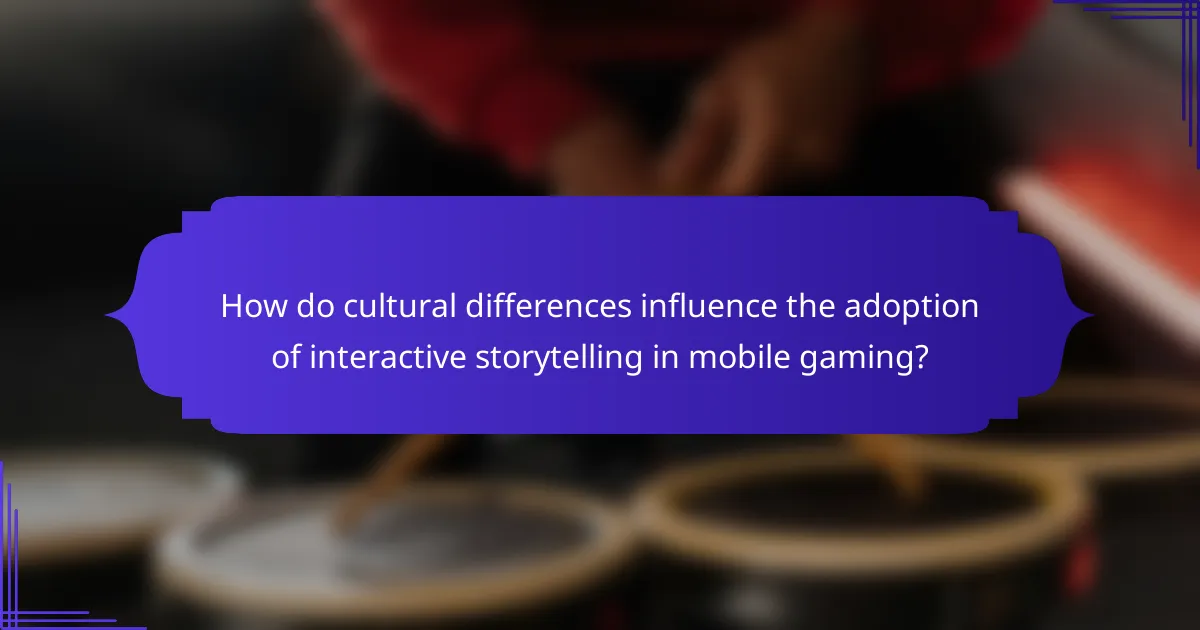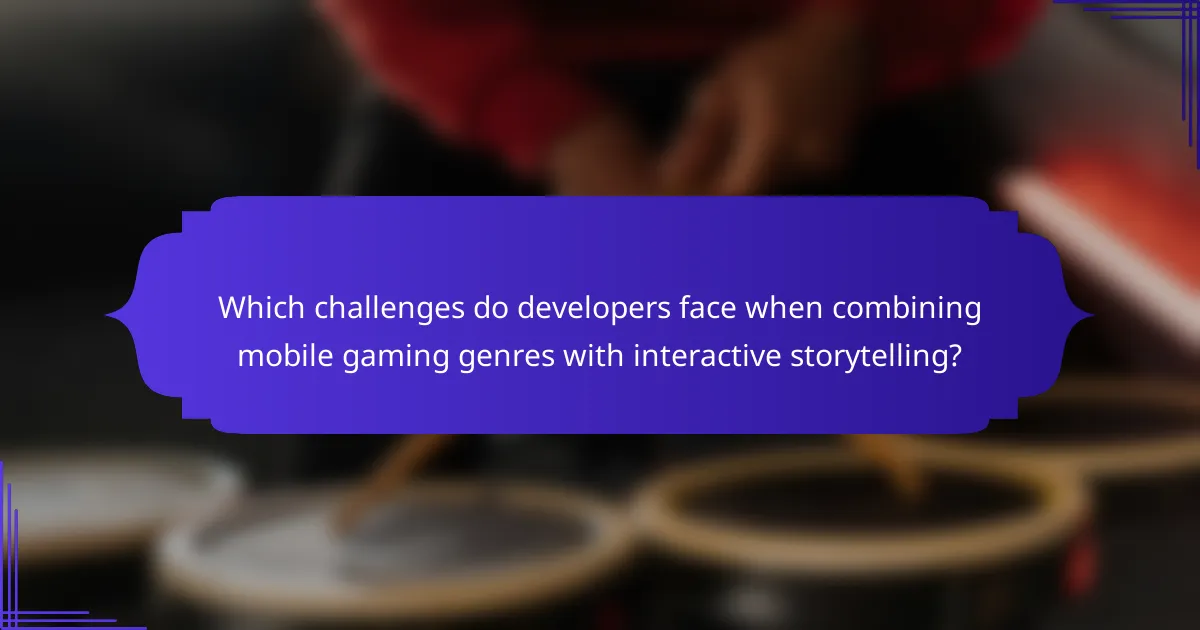Mobile games are increasingly merging popular genres with interactive storytelling elements, enhancing player engagement and emotional connection. Role-playing games and adventure games leverage branching narratives and character choices. Simulation games incorporate real-life scenarios, adding depth to gameplay. Cultural differences influence narrative preferences, shaping how stories resonate with diverse audiences.

What are the key features of popular mobile game genres that incorporate interactive storytelling elements?
Popular mobile game genres that incorporate interactive storytelling elements include role-playing games, adventure games, and simulation games. These genres enhance player engagement through narrative-driven gameplay.
Role-playing games (RPGs) often feature character progression and branching storylines, allowing players to shape narratives based on choices. Adventure games emphasize exploration and puzzle-solving within rich story contexts, creating immersive experiences. Simulation games integrate storytelling with real-life scenarios, offering players narrative depth alongside gameplay mechanics.
Each genre utilizes interactive storytelling to deepen emotional connections, enhance replayability, and foster community engagement. This merging of storytelling with gameplay mechanics is a unique attribute that distinguishes these genres in the mobile gaming landscape.
How do narrative-driven mechanics enhance player engagement in mobile games?
Narrative-driven mechanics significantly enhance player engagement in mobile games by creating immersive experiences. These mechanics allow players to form emotional connections with characters and storylines, fostering deeper investment in gameplay.
Players are more likely to remain engaged when they encounter branching narratives that adapt to their choices. This interactivity encourages exploration and replayability, as players seek different outcomes. For example, games like “Life is Strange” and “The Walking Dead” utilize choice-driven storytelling to maintain interest.
Additionally, integrating rich narratives can elevate the perceived value of mobile games, leading to increased player retention. Players often return to games that offer evolving plots and character development, enhancing long-term engagement.
Finally, narrative-driven mechanics can facilitate social interactions among players. Sharing experiences and discussing story outcomes creates a community around the game, further enhancing player involvement.
Which mobile game genres are most commonly merging with interactive storytelling?
Popular mobile game genres merging with interactive storytelling elements include role-playing games, adventure games, simulation games, narrative-driven puzzle games, and visual novels. These genres enhance player engagement through immersive narratives and character development. Role-playing games often allow players to shape their story through choices. Adventure games focus on exploration and problem-solving within a narrative context. Simulation games incorporate storytelling to create relatable scenarios. Narrative-driven puzzle games combine challenges with story progression, while visual novels prioritize storytelling through text and character interactions.
What role does player choice play in interactive storytelling within mobile games?
Player choice significantly enhances interactive storytelling in mobile games by creating personalized experiences. This engagement fosters deeper emotional connections and investment in the narrative. Players shape the story’s direction through decisions, impacting character development and plot outcomes. Unique branching paths emerge from these choices, allowing for varied gameplay experiences. This interactivity transforms passive consumption into active participation, making the storytelling more immersive and dynamic.

How do cultural differences influence the adoption of interactive storytelling in mobile gaming?
Cultural differences significantly shape the adoption of interactive storytelling in mobile gaming. These variations influence narrative preferences, character development, and gameplay mechanics.
For instance, cultures with strong oral traditions may favor storytelling that emphasizes narrative depth and character arcs. In contrast, cultures that value fast-paced entertainment might prefer quick, action-driven plots.
Moreover, cultural values impact how players relate to characters and moral dilemmas presented in games. Games that resonate with local customs and beliefs tend to see higher engagement and adoption rates.
As a result, developers must consider cultural nuances to create interactive stories that appeal to diverse audiences, enhancing user experience and retention.
What are the preferences of North American players regarding narrative content in mobile games?
North American players prefer mobile games that blend engaging narratives with interactive elements. These preferences reflect a growing demand for immersive storytelling, enhancing player engagement.
Key genres that successfully merge narrative content include role-playing games (RPGs), adventure games, and simulation games. RPGs often feature rich storylines and character development, while adventure games focus on exploration and puzzle-solving within a narrative framework. Simulation games provide players with scenarios that allow for narrative choices affecting outcomes.
Moreover, players appreciate dynamic storylines that adapt based on their decisions, creating a personalized gaming experience. This trend highlights the importance of player agency in narrative-driven mobile games, leading to higher satisfaction and retention rates.
In summary, North American players favor mobile games that offer interactive storytelling, character depth, and player-driven narratives, reflecting a shift towards more engaging and personalized gaming experiences.
How do European mobile gamers perceive interactive storytelling compared to traditional gameplay?
European mobile gamers tend to favor interactive storytelling over traditional gameplay due to its immersive nature. This genre allows players to engage deeply with narratives, enhancing emotional connections to characters and plot.
Research indicates that 65% of mobile gamers appreciate games that blend story with gameplay elements. Titles like “Life is Strange” and “The Walking Dead” exemplify this trend, showcasing player choice and branching narratives.
The unique attribute of interactive storytelling is its ability to adapt based on player decisions, creating a personalized experience. This contrasts with traditional gameplay, which often follows a linear progression.
As a result, interactive storytelling in mobile games is gaining traction, appealing to players seeking richer, more engaging experiences.

Why are some mobile games more successful in integrating storytelling elements than others?
Some mobile games excel in integrating storytelling elements due to their immersive narratives and character development. Successful genres like role-playing games (RPGs) and adventure games prioritize player engagement through rich storylines. These games often feature unique attributes, such as branching narratives and player choices, enhancing emotional investment. Additionally, the use of high-quality graphics and sound design can elevate storytelling, creating a more captivating experience. As a result, players are more likely to connect with the game and its characters, leading to higher retention and success rates.
What unique attributes do standout mobile games possess in their storytelling approaches?
Standout mobile games often feature immersive narratives, character depth, and player choices that impact the story. Unique attributes include branching storylines that adapt based on player decisions, emotional engagement through relatable characters, and innovative use of multimedia elements like visuals and sound. These aspects create a personalized experience, enhancing player investment in the game’s outcome. Additionally, some games incorporate real-time decision-making, adding urgency and excitement to storytelling.
How does the integration of visual and audio elements enhance storytelling in mobile games?
The integration of visual and audio elements significantly enhances storytelling in mobile games by creating immersive experiences. Visuals provide context and emotional cues, while audio elements, such as music and sound effects, deepen engagement and evoke feelings. This synergy captivates players, making narratives more memorable and impactful. For example, a well-timed sound effect can heighten tension during critical moments, while vibrant graphics can illustrate complex storylines. Together, these elements transform gameplay into a compelling narrative journey, fostering a stronger connection between players and the story.

Which challenges do developers face when combining mobile gaming genres with interactive storytelling?
Developers face challenges in balancing gameplay mechanics with narrative depth. Merging genres often leads to conflicts between player agency and story progression. Maintaining player engagement while ensuring a cohesive narrative structure is difficult. Additionally, technical limitations may hinder the integration of complex storytelling elements.
What are common pitfalls in narrative design for mobile games?
Common pitfalls in narrative design for mobile games include lack of player agency, overly complex plots, and insufficient character development. These issues hinder player engagement and can lead to frustration.
1. Lack of player agency: Players may feel disconnected if their choices do not impact the story.
2. Overly complex plots: Complicated storylines can confuse players, making it hard to follow.
3. Insufficient character development: Flat characters reduce emotional investment and immersion.
4. Ignoring mobile constraints: Failing to adapt narratives for shorter play sessions can alienate players.
How can developers balance gameplay mechanics with storytelling without compromising either?
Developers can balance gameplay mechanics with storytelling by integrating narrative-driven design within popular mobile game genres. This approach enhances player engagement while maintaining gameplay integrity.
Utilizing elements like character development, plot progression, and player choices allows for a seamless blend of storytelling and mechanics. For instance, role-playing games often feature rich narratives that evolve based on player decisions, creating a personalized experience.
Moreover, mobile puzzle games can incorporate story elements through themed levels or character backstories, enriching the gameplay without overwhelming the mechanics. This creates a cohesive experience where players feel motivated to progress both in gameplay and narrative.
Ultimately, the key is to ensure that gameplay mechanics serve the story and vice versa, fostering an immersive environment that captivates players.

What emerging trends are shaping the future of mobile games with interactive storytelling?
Emerging trends in mobile games are increasingly blending genres with interactive storytelling. This fusion enhances player engagement and creates immersive experiences.
One significant trend is the rise of narrative-driven role-playing games (RPGs). These games often incorporate branching storylines, allowing players to make choices that impact the narrative outcome. This unique attribute creates a personalized gaming experience.
Another trend is the integration of augmented reality (AR) in mobile storytelling. AR games, such as Pokémon GO, use real-world environments to enhance the narrative, making gameplay more interactive and engaging. This root attribute of AR technology deepens immersion.
Additionally, mobile puzzle games are incorporating storytelling elements. Players solve puzzles to advance through a narrative, adding depth to the gameplay. This rare attribute attracts players who seek both challenge and story.
Lastly, social interaction features are becoming more prominent. Many mobile games now allow players to collaborate or compete in storytelling scenarios, fostering community engagement. This trend reflects a shift towards shared experiences in gaming.
How is technology, such as AI and AR, influencing narrative experiences in mobile gaming?
Technology, particularly AI and AR, significantly enhances narrative experiences in mobile gaming. These advancements create immersive environments that adapt to player choices, enriching storytelling.
AI algorithms analyze player behavior, tailoring narratives to individual preferences. This personalization results in unique gameplay experiences, fostering deeper emotional connections.
AR technology overlays digital elements onto the real world, allowing players to interact with stories in innovative ways. This integration transforms traditional narratives into dynamic experiences that engage players physically and emotionally.
As mobile games increasingly adopt these technologies, the fusion of interactive storytelling and gameplay becomes more pronounced. Players now participate in evolving narratives, making choices that influence story outcomes, thus revolutionizing mobile gaming.
What player feedback mechanisms are essential for improving storytelling in mobile games?
Player feedback mechanisms essential for improving storytelling in mobile games include surveys, in-game analytics, and community forums. These tools gather insights on player preferences, engagement levels, and narrative impact.
Surveys allow developers to collect direct opinions on story elements and character development. In-game analytics track player choices and behaviors, revealing which story arcs resonate most. Community forums encourage discussions, enabling players to share experiences and suggestions, which can enhance narrative depth.
Utilizing these feedback methods can lead to more immersive storytelling, ultimately increasing player satisfaction and retention.
What best practices should developers follow to optimize interactive storytelling in mobile games?
Developers should focus on narrative coherence, player agency, and emotional engagement to optimize interactive storytelling in mobile games. Prioritize a strong storyline that allows players to make meaningful choices, enhancing immersion. Incorporate dynamic dialogue systems that adapt to player decisions, fostering a personalized experience. Utilize visuals and audio to reinforce the narrative, creating an engaging atmosphere. Regularly test player feedback to refine story elements and ensure they resonate with the audience.
